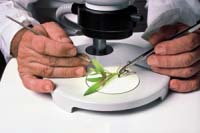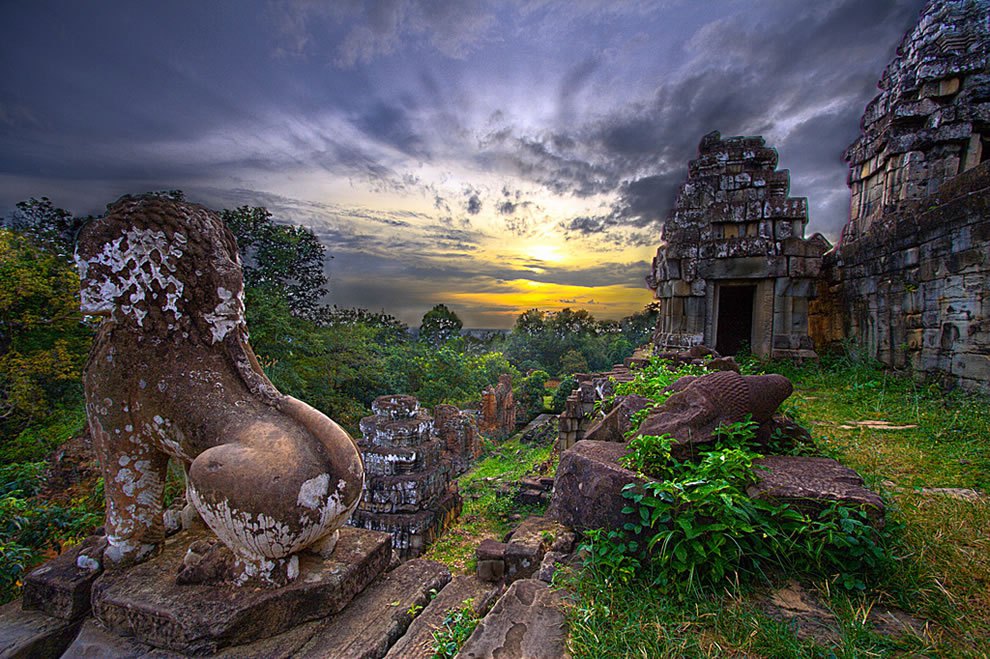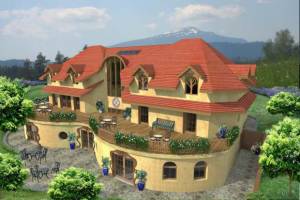
The Effect of Energy Field of Agnihotra on Water Purification
Dr Ulrich Berk from Germany has conducted several scientific experiments with Agnihotra.
One experiment was conducted at the Homa Therapy Goshala in Maheshwar, MP, India in 2013. The experiment is important because it shows that there is an energy field around Agnihotra which causes the purification effect in water and this energy is not of the known electromagnetic type.
Agnihotra is a special fire performed exactly at the time of sunrise and sunset in a copper pyramid. It comes from ancient Vedic Knowledge. Agnihotra is said to purify the environment and especially it has been found to have profound impact in mitigating water pollution problem. The present study shows that water will be purified if it is kept in a room where Agnihotra is regularly performed. Water purification also happens if water bottles are kept inside a Faraday Cage in the Agnihotra room. These results suggest that Agnihotra creates an energy field beyond the electromagnetic field which has profound impact.
Availability of potable drinking water is becoming increasingly a worldwide problem. Dumping of industrial wastes, radiation coming from the bowels of the earth and from a number of human activities, atmospheric pollution, all are affecting availability of water suitable for human consumption and for agricultural use. This, coupled with acid rains further aggravates the situation. Therefore, inexpensive and easily available methods of water purification are becoming more and more important. Some reports suggest that the ancient method of Agnihotra may offer a cheap and affordable solution
Preliminary tests have shown that if Agnihotra ash is added to polluted water, it gets purified (Mondkar1, Gerlecka2, Matlander3). Further, Matlander showed that if you not only add Agnihotra ash to water but also keep the water in Agnihotra atmosphere (in a room where Agnihotra is performed regularly), the reduction of pathogenic bacteria is higher. Sharma4 then went one step further and did not add Agnihotra ash but just kept water bottles next to a Somayag (a long lasting process of fire purification – but which is also based on the principles of Agnihotra). Observation was that also in this case water was purified. But since the bottles were open, a chemical effect of smoke particles cannot be excluded.
Sharma5 also showed that Agnihotra atmosphere not just locally purifies water but leads to the purification of a whole river in its vicinity.
The object of the present experiment was to see whether just Agnihotra atmosphere without any effect of Agnihotra ash or Agnihotra smoke would be able to improve water quality (Agnihotra atmosphere has been reported to have a positive effect on the sprouting of seeds, see Devi/Swamy/Nagendra6).
A first test showed that after a period of 5 days the count of Coliform bacteria was reduced by more than 50% compared to control (same water kept in the laboratory during these 5 days).
As any chemical reaction with either ash or smoke of Agnihotra was excluded the effect could only be in terms of physics. This leads to the assumption that regular performance of Agnihotra creates some kind of energy field which helps to purify water. But which kind of energy field could this be?
In every day life the most common energy fields are electromagnetic fields. Could it be that electromagnetic fields lead to the purification effect of Agnihotra on water?
In order to find out whether electromagnetic fields generated by Agnihotra are responsible for the improvement of water quality the following systematic studies were designed. It is well known that Faraday Cages shield electromagnetic waves. Therefore, if the effects of Agnihotra on water are (partly) based on some electromagnetic waves, then there would be no (less) change in the parameters of water quality if this water is kept in such Faraday Cages. This was to be tested.
Materials and methods
1) Agnihotra
Agnihotra is the smallest and basic Homa healing fire which is performed in a copper pyramid of fixed size and shape, tuned to the biorhythm of sunrise/sunset. It comes from the ancient most Vedic Sciences of Bioenergy, Medicine, Agriculture and Climate Engineering. This knowledge has been revived by Shree Gajanan Maharaj from Akkalkot, Maharashtra last century and taught worldwide by his disciple Shree Vasant Paranjpe7. A compilation of recent research on Agnihotra and Homa Therapy is given in Berk/Johnson 20098
In this ancient tradition sunrise is described as follows:
“At sunrise the many fires, electricities, ethers and more subtle energies emanating from the sun extend all the way to the Earth and produce a flood effect at those coordinates where the sun is said to rise. It is awesome. The flood enlivens and purifies everything in its path, destroying what is impure in its wake. This torrent of life-sustaining energies causes all life to rejoice. At sunrise that music can be heard. The morning Agnihotra Mantra is the essence of that music. It is the quintessential sound of that flood. At sunset the flood recedes” (Paranjpe 1989).
1) The materials used for present study consist of following:
A pyramid shaped copper container, 14.5 cm x 14.5 cm at the top, 5.25 x5.25 cm at the bottom and 6.5 cm in height.
2) Fire prepared with cow dung patties duly smeared with cow’s ghee and its offering to fire along with chanting following Agnihotra Mantras.
At sunrise:
Sooryáya swáhá, sooryáya idam na mama
prajápataye swáhá, prajápataye idam na mama
At sunset:
Agnaye swáhá, agnaye idam na mama prajápataye swáhá,
prajápataye idam na mama
2) Conducting the experiment
For the experiment water was taken with a bucket from the Narmada River in Mandleshwar, Madhya Pradesh, India (22° 10′ 29” North, 75° 39′ 59” East). The water was stirred and then distributed into glass bottles for experimentation.
Three bottles for control were immediately brought to the laboratory of Shri Umia College, Mandleshwar, MP (first two replications) and of AIMS College, Dhamnod, MP (third replication plus several control experiments). The measurements took place between October 2012 and February 2014.
Seventeen bottles were brought to the Homa Therapy Goshala in Maheshwar, MP. Three each of the bottles filled with water were put in containers made of stainless steel, copper and aluminum, respectively. Care was taken that there was no direct contact between the bottles and the metal containers. At the bottom of the metal containers a piece of dried cow dung was placed and at the sides a distance of one cm was kept. Then, the metal containers were closed with a tightly fitting lid in order to get Faraday Cages.
In addition to these 9 water bottles enclosed in metal containers for comparison, also 8 bottles without metal containers (filled with the same water from Narmada River) were used.
All these bottles were placed in the Agnihotra hut at Maheshwar Homa Therapy Goshala where Agnihotra has been performed regularly exactly at sunrise and sunset. No other activities are going on in this Agnihotra hut, and no words other than mantras related to Agnihotra are spoken there.
Figs. 1 & 2 show both shielded and unshielded bottles in the Agnihotra hut, and Fig. 3 shows the arrangement of all water bottles for the experiment.

Fig. 1 – Left side: Water bottles in metal Fig. 2 – Unshielded bottles
containers; Right side: Agnihotra is
performed in the left-hand pyramid.
The temperature in the Agnihotra hut (where the experimental samples were kept) and the office room of the laboratory (where the control samples were kept) showed only minor differences.
After 5 days all water samples were taken out from the Agnihotra hut and brought to the laboratory for testing. These samples plus those kept there for control were examined for the most important physico-chemical parameters of water: Dissolved Oxygen (DO), pH, Chemical Oxygen Demand (COD), hardness, and count of Coliform bacteria.
Physico-chemical parameters of water were determined as per standard methods of APHA9 and Welch10
Parameters like temperature, pH, Dissolved Oxygen (DO), and turbidity were determined at the site, while other parameters like Chemical Oxygen Demand (COD), chloride, phosphate, nitrate, alkalinity, free CO2, total solids were determined in the laboratory.
The tests were conducted according to single blind protocol: To prevent bias in the results all bottles were marked with numbers only before testing in the laboratory.
Results and discussion
The experiment was done with three replications. All showed considerable improvements in water quality compared to control in all the five parameters tested. Table 1 shows the results in detail, Table 2 shows the percentage changes as compared to control.
Fig. 4 is a graphical representation comparing properties of all the water samples kept in Agnihotra atmosphere versus control.
There was a general improvement of water quality in all the parameters measured as compared to control. These changes are consistent through all three replications.
Although there was some difference between the water samples kept in metal containers and the samples kept in bottles regarding DO, pH, and COD, this difference was rather small compared to the difference with control (Fig. 5).
Also, there were some differences between the different kinds of metal containers – but again these differences were small compared to the difference with control. Further, experiments could look deeper into these differences.
The main results with all three replications and all parameters of water quality are that:
a) Agnihotra atmosphere helps to purify water.
b) This effect of purification is there whether or not the water samples are kept in Faraday Cages.
The conclusion seems natural that there is some kind of energy field around Agnihotra which is not of the known electromagnetic type and which is not shielded by Faraday Cages.
If someone has some alternative explanation it would be interesting to hear about that.
More detailed discussion
The biggest variation between the samples kept in bottles inside the 3 different metal containers was in Dissolved Oxygen (DO). Water kept in stainless steel showed much pronounced effect, while impact was least in water kept in aluminum container.
Also, there was some difference between the samples just kept in bottles and the samples where the bottles where kept in these metal containers acting as Faraday Cages: samples in Faraday Cages showed less improvement. One possible explanation for that result could be related to temperature. It is known that DO is affected much by the prevailing temperature. Temperature in the Agnihotra hut was measured before/after Agnihotra (at a distance of appr. 50 cm from the fire). Normally the temperature went up by 10 C after Agnihotra and came down to the value before Agnihotra within 20 or 30 minutes. Probably this small change of temperature which also lasted for a short time band can be neglected.
Possible that metal containers absorb the infrared radiations from the Agnihotra fire and store the heat for longer time so that inside the containers the temperature is increased for longer time than outside. But then one would expect the samples in the containers next to the Agnihotra fire to have least Dissolved Oxygen (DO) and those furthest away the highest level of DO. The data are not conclusive in this respect. Still, this hypothesis can be tested in future experiments by putting some temperature sensor inside the metal containers.

The main result though is not affected by these variations between the three replications and between the bottles in different materials used for shielding – the significant improvement of water quality of all parameters which were measured if the water is kept in Agnihotra atmosphere.
Containers of metals like copper, steel, or aluminum work well as a Faraday Cage to shield electromagnetic waves of a wide range. But if you go to the end of very high energy radiation (like gamma rays), these containers used cannot prevent rays from penetrating inside. For further studies, it is suggested to do an experiment in which a container of lead is used instead. One centimetre of wall thickness should be enough to at least make a difference in the effect on water. The present study showed some interesting observations in mitigating water pollution problem. Considering importance further systematic research studies are suggested. The experimental design can be modified in different directions:
a) Have samples at different distances from the Agnihotra pyramid (The distances inside the Agnihotra hut varied from 50 cm to approximately 3 m – this did not have a clear effect on the results).
Samples could be placed outside the Agnihotra hut at different distances.
This would also help to see whether the effects of Agnihotra energy field inside and outside of the Agnihotra hut are same at same distance or not.
b) Put the samples in a room where Agnihotra has never been performed before and will be just performed for the 5 days of the experiment. This would help to find out whether the energy field is building up over a period of time.
Possible also to put the samples in an Agnihotra hut with continuous Agnihotra for several years-but not perform Agnihotra during the time of the experiment and see whether the energy field of Agnihotra is still present after some time of nonperformance.
c) Keep the samples one day only, two days, etc. to see how fast these changes in water quality happen – and also continue for say 30 days to see whether the improvement continues or stops at some point. Most interesting though is the question: which kind of energy field is created by Agnihotra and how this type of energy field brings about the changes in water quality (assuming the possibility of high energy electromagnetic waves which can not be shielded by the type of Faraday Cage used can be excluded).

Table 2 – Percentage changes as compared to control

Fig. 4 – Comparison of properties of water kept in Agnihotra atmosphere versus control (%)

Fig. 5 – Comparison of properties of water kept in Agnihotra atmosphere (in unshielded bottles and bottles with shields from different materials) versus control (%)
For future studies, two hypotheses are suggested:
1) There are microorganisms in polluted water which are activated by Agnihotra energy field and thus help to improve properties of water.
2) Agnihotra creates an energy field in the vicinity which is not confined to electromagnetic fields.
The first hypothesis requires further studies in the field of Microbiology, identifying microorganisms which can help improve water quality and examine closely how their activity is influenced by Agnihotra atmosphere.
The second hypothesis puts a challenge for physicists. The pyramid shape of the Agnihotra vessel probably plays some role – not much researched yet, but there are some preliminary studies in this field11.
An important study would be: which kind of energy field could this be? One possibility is “Prana” energy – but then this concept of “Prana” has to be translated into the language of modern science, and especially methods of measuring Prana energy will be required12.
A lot of interesting further studies are necessary, and these could help to get a better understanding of such basic Vedic concepts as “Prana” in terms of modern Science. All scientists from different disciplines are invited to join forces!
References
1 Mondkar A, Agnihotra and Microbes, A Laboratory Experience, Satsang, 9 (20) (1982) 2-7.
2 Gerlecka E, Observations with Agnihotra Ash and Water, Satsang, 16 (1-3) (1988) 11.
3 Matlander J, Study of the Effect of Agnihotra Ash on Pathogenic Bacteria, Unpublished Paper, 2013.
4 Sharma S, Water Quality Purification Through Homa Therapy, will be published in 2014.
5 Sharma S, Sengupta T & Kapil S, Somayag Influences on Different Parameters of Narmada River, Indian Res Comm, 5(1) (2011) 55-56.
6 Devi HJ, Swamy NVC & Nagendra HR, Effect of Agnihotra on the germination of rice seeds, Indian J Tradit Knowle, 3(3) (2004) 231-239.
7 Paranjpe VV, Homa Therapy – Our Last Chance, (Fivefold Path Inc., Madison, VA, USA), 1989.
8 Berk U & Johnson B, Bringing Homa Farming into the Mainstream of Indian Agricultural System, (Fivefold Path Publications, Dhule), 2009.
9 APHA (American Public Health Association): Standard Methods for the Examination of Water and Wastewater, 21st edn, American Water Works Association and Water Pollution Control Federation, Washington, D.C 2002.
10 Welch PS, Limnological methods, (McGraw-Hill Book Co., New York), 1998.
11 Itagi RK, Swamy NVC & Nagendra HR, Effect of Pyramids on Microorganisms, Indian J Tradit Knowle, 4(4) (2005) 373-379.
12 Recently there are different methods which seem to do that – like PIP (Polycontrast Interference Photography), GDV (Gas Discharge Visualization technique, developed by K. Korotkov on the basis of Kirlian photography), and Life Energy Meter measurements. More research with these methods is planned for the future.



